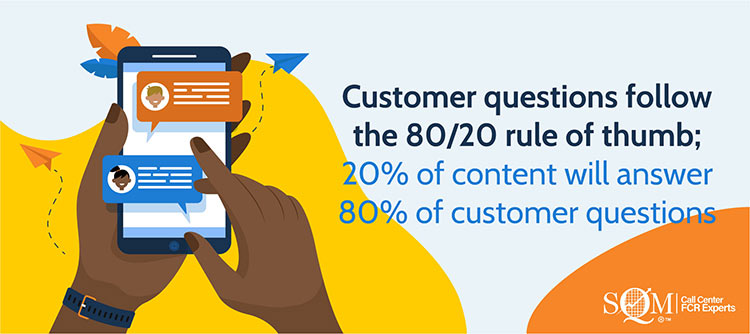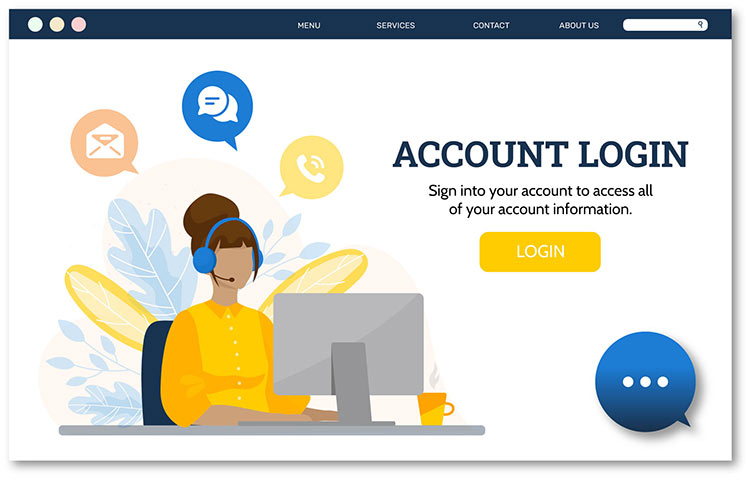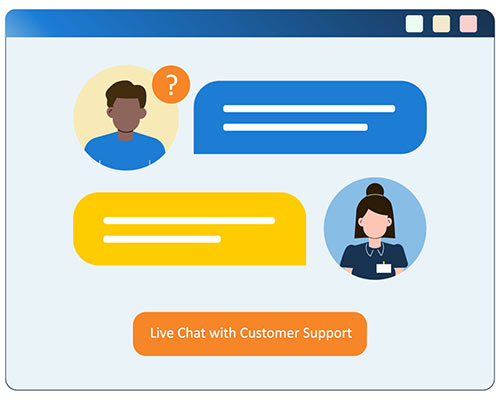Agent Chat Touchpoint
Many experts feel that the email touchpoint displaced the fax and mail contact touchpoints. New contact touchpoints displace older touchpoints when the new touchpoints are easier for customers to resolve an inquiry or problem. Furthermore, experts now feel that the chat touchpoint will partially displace the email touchpoint. The chat touchpoint will partially displace the email touchpoint because the two-way communication available in the chat touchpoint is almost real-time. Historically, the chat touchpoint has not been appropriate for complex inquiries, problems, or complaints, especially when there is a need for required documentation. Some contact centers can upload documents to the chat session, which is a best practice. Also, some contact centers will send the customer a copy of the chat session via email or allow an online document to be downloaded, providing reference documentation to the customer.
What organizations like most about the chat touchpoint are that it cuts costs because a chat agent can have more than one chat session at the same time with different customers. A well-trained chat agent can effectively handle up to three chats simultaneously. However, if a chat agent takes too many simultaneous chats, First Call Resolution (FCR) and Customer satisfaction (Csat) will drop. Therefore, it is essential to use workforce management to handle chat agent sessions effectively and efficiently. In addition, chat agents can use many techniques and tools such as 'hot keys' that provide template answers to typical questions. In most cases, when using the chat touchpoint, customer questions follow the 80/20 rule of thumb; 20% of content will answer 80% of customer questions. In other words, the questions that chat agents handle are very similar from session to session. Hotkeys allow agents to have appropriate templated responses to this 20% of content applicable in most chat sessions.

Contact centers need to train agents on the necessary chat writing skills for resolving customer inquiries or problems. Unfortunately, many agents speak better than writing to resolve customer inquiries or issues. As a result, organizations will need to address the issues of hiring agents with good writing skills and/or providing agents with writing skills training. Agents should use sentences that are cheerful, polite, and positive. Attitude does matter when resolving a customer's inquiry or problem, even at a chat touchpoint.
A best practice for the chat touchpoint is to provide customers with a quick response time. Response time is the most significant factor in satisfaction for chat usage. Customers have very little patience for a slow response time when using a chat touchpoint, and they will quickly abandon the touchpoint if the response time is too slow. A response time of one minute or less, in most cases, is a response time standard. However, many customers expect a real-time response. Customers will end chat sessions if idle time is too long. If an agent is looking into something for the customer and will take longer than one minute, they must stay engaged with the customer by sending short messages that do not appear to be a canned response. The agent must inform the customer that they are taking the time to get the necessary information to help them resolve the inquiry or problem.
Contact centers should use chat management software to ensure a quick response time. Effective chat management software should log all incoming chat sessions. In addition, the chat management software should use automated queuing to assign the chats to the appropriate agent with the right skill set. The software can then monitor the speed and quality of the chat responses. Chat traffic can also be monitored to determine when spikes in the number of chat sessions occur. Contact centers should have plans for how to handle these chat spikes. For example, customers should be provided with chat time operating hours and, if necessary, estimated wait times for an available chat agent. Chat management software can also flag conversation sessions of concern for follow-up action.
Many contact centers use chatbot (also known as virtual assistant) software powered by artificial intelligence (AI) for handling customer inquiries and problems. The chatbot uses an automated program that interacts with customers as a human would and costs very little to interact with customers. In addition, chatbots attend to customers at all times of the day and week and are not limited by time or physical location. Therefore, the chatbot makes its implementation appealing to many businesses that may not have the workforce or financial resources to keep agents working around the clock.
The chat touchpoint is known as the 'safety net' touchpoint for helping customers resolve their inquiry or problem when using the web self-service touchpoint. This primarily has been achieved by having the chat touchpoint be available and helpful for assisting customers when using the web touchpoint. In most cases, a failed web self-service interaction results in a phone call to the call center. An effective chat touchpoint practice can avoid calls to the call center, which is a cost-saving for the organization and will result in higher Csat.
After a customer uses the chat touchpoint, it is essential to determine the customer experience using this touchpoint. One way to assess customer experience is with a survey invitation link at the bottom of the chat window. The survey should ask the following questions:
- Overall how satisfied were you with our chat customer service?
- Was your inquiry or problem resolved?
- How many chat sessions did it take to resolve your inquiry or problem?
- Why did we not resolve your inquiry or problem?
- How satisfied were you with our response time?
- Did you find the chat functionality easy to use?
- Did you have to use another touchpoint to resolve your inquiry or problem?
The survey invitation link at the bottom of the chat window captures polarized customer feedback because only very satisfied or dissatisfied customers are more likely to respond to the survey. However, the survey results still provide trends and improvement opportunity insights. Therefore, randomly surveying customers using an outbound phone or email survey is a best practice to determine the chat touchpoint Csat accurately.
Proactive Agent Chat Practice
Organizations are becoming more proactive with their chat touchpoint practice. Historically, the chat touchpoint has used a static' click here to chat' button invitation, available in a single location on the website. The static chat button is a reactive practice because it waits for the customer. While a static chat button on a website can be appropriate, most organizations benefit from a proactive chat practice. A proactive chat practice invites a customer to have a conversation rather than just waiting for the customer to initiate. A proactive chat practice makes customers more likely to stay within the website when they have issues resolving their inquiry or problem rather than phoning the call center. The chat button in the corner of the screen with the ability to be hidden can be an effective practice. Aggressive chat pop-up invites can be a customer turn-off. Most customers prefer chat options that they can use as and when they want to.
An effective proactive chat practice, which is well accepted and valued by customers, is having the chat option available when a customer logs in to their account. When a customer has authenticated and then uses chat, the agent can identify them, look at their account information, review past interactions, and personalize the conversation. If a proactive chat practice is going to be used, organizations should build the proactive chat practice based on the chat touchpoint's usage data. Most of the required information for a proactive chat practice is available on the website and chat usage reports. Examples of information required to build an appropriate proactive chat practice include answers to questions such as:
- Where do customers' bail out' on the website?
- What percentage of customers use the static chat button and/or the proactive chat invites?
- What questions do customers ask the most?
- What pages on the website do customers use chat?
- What topics have the lowest chat FCR or Csat?

Summary of Agent Chat Touchpoint Best Practices
The following is a summary of chat touchpoint best practices for resolving an inquiry or problem:
- Make chat universally accessible across all website pages. Use proactive chat wisely; in other words, do not use aggressive pop-up chat invites
- Use chat management software that logs all chats and uses automated queueing to assign the chats to the appropriate agent with the right skill set and then monitor responses' speed and quality. Chats of concern can then be flagged for follow-up action
- Track chats to better understand customer needs and issues based on questions asked
- Link a survey to the chat session to capture customer experiences. Then have supervisors coach agents on opportunities to improve
- Conduct random outbound email or phone customer surveys to determine customer experiences when using the chat touchpoint
- Train agents on correct writing skills for resolving inquiries or problems in the chat touchpoint
- Use sentences that are cheerful, polite, and positive. Remember, attitude matters when resolving a customer's inquiry or problem
- Use dedicated chat/email agents who are skilled at handling chat/emails (e.g., good writing skills and polite messaging)
- Ensure a quick response time. An immediate answer is the best chat response time. However, one minute or less is an acceptable standard
- Avoid idle chat time by sending messages to the customer informing them that the agent is still working on resolving their issue. In other words, keep the customer up-to-date on what is being done
- Monitor chat traffic. Plans need to be made to handle chat spikes. Provide customers with chat time operating hours and, if necessary, estimated wait times for an available chat agent
- Chat agents should not handle more than three different chats at the same time
- Ensure chat agents know the hotkeys or shortcuts. Develop a shortcut guide that agents can print out and use
- Increase consistency of chat responses by using template-based answers that agents can personalize
- Personalize the chat by using customer account information or past interactions
- Show empathy by acknowledging the customer's situation
- Have the QA team evaluate 5 to 10 chats per agent per month. Then have the supervisors coach agents on opportunities to improve
- Achieve a chat resolution target of 95% and an FCR target of 80%
- Hold agents accountable for the chat resolution metric and hold management accountable for the FCR metric
- Report daily, weekly, monthly, and yearly chat resolution and FCR performances to senior management
- Gather chat data often and report to management (e.g., chat usage, FCR, call resolution, Csat, bounce rates, or customer had to use phone agent to resolve their inquiry)
- Increase the understanding of the customer experience by using text analytics for specific words or phrases to discover satisfaction and dissatisfaction levels
- Use a chat management system for performance reporting to hold the chat team accountable and make improvements
- Integrate the chat touchpoint interactions with the CRM system. Remember, customers expect to be able to move between contact touchpoints seamlessly

Quick Related Links
First Call Resolution Definition First Call Resolution PPT First Call Resolution Benefits First Call Resolution Strategies First Call Resolution Operating Philosophy First Call Resolution Formula What is a Good FCR Rate? One Contact Resolution Channel Hopping Journey Mapping for Touchpoints
